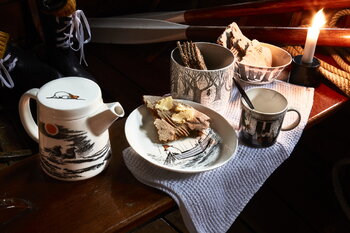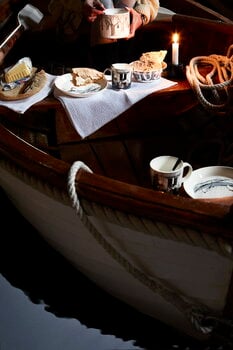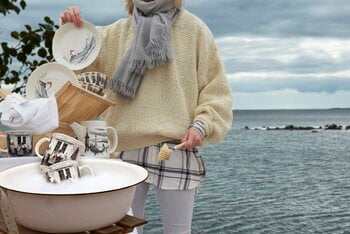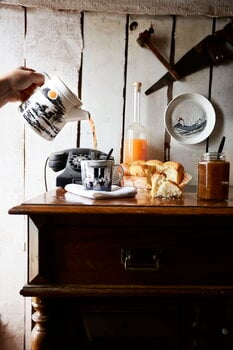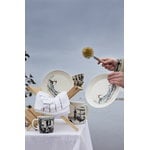Arabia’s Moomin plate True to Its Origins is part of a tableware collection inspired by Tove Jansson’s novels Moominpappa at Sea (1965) and Moominvalley in November (1970). The first one tells the story of the Moomin family moving to a far-away lighthouse island, and the latter is the artist’s last Moomin book that she wrote after her mother had passed away. The themes of the books – longing, loneliness and turning points in life – are conveyed in the ceramic teapot, jar, plate, bowl and mug through Jansson’s beautiful, melancholy illustrations.
Moomin plate, True to Its Origins
Moomin Arabia
Description
Arabia’s Moomin plate True to Its Origins is part of a tableware collection inspired by Tove Jansson’s novels Moominpappa at Sea (1965) and Moominvalley in November (1970). The first one tells the story of the Moomin family moving to a far-away lighthouse island, and the latter is the artist’s last Moomin book that she wrote after her mother had passed away. The themes of the books – longing, loneliness and turning points in life – are conveyed in the ceramic teapot, jar, plate, bowl and mug through Jansson’s beautiful, melancholy illustrations.
Product details (4)
- Material
- Ceramic
- Colour
- White
- Diameter
- 19 cm
- Care instructions
- Safe for dishwasher, oven, microwave and freezer
- Product ID
Designer
Tove Jansson (1914–2001) is one of the most famous Finnish artists, known especially for her Moomin characters. Besides a productive writer and illustrator, Jansson was also a painter and cartoonist. During her career Jansson wrote and illustrated over ten Moomin books and about 1500 comic strips. Her best known pieces as a painter include the decorations of the Aurora Children's Hospital in Helsinki and the large frescos that nowadays belong to the collections of Helsinki Art Museum.
Jansson’s life was full of art since a child: she grew up in a Fenno-Swedish artist home with her parents, sculptor Viktor Jansson and graphic artist Signe Hammarsten-Jansson. Also her brother Lars worked as an artist. In the 1930s Jansson studied commercial drawing and design in Stockholm, and continued with painting studies at the Finnish Art Academy School. Jansson lived most of her life in Helsinki, and spent time also with her mother’s family in Sweden and at the secluded island of Klovharu with her partner, graphic artist Tuulikki Pietilä.
Jansson’s Moomins belong to the most beloved characters of Finnish culture. The first Moomin books were published in the 1940s, and today Moomins have found their ways to television, theatres, stamps, coins and various different products, such as Arabia’s Moomin mugs and tableware. Moomins’ benevolent open-mindedness, joyful bohemian lifestyle and deep philosophical perspective on the world have charmed both children and adults in Finland and abroad, and the Moomin books have been translated to about 45 languages.
During her long career Tove Jansson was awarded with numerous different prizes, such as the Hans Christian Andersen award in 1966 and the Pro Finlandia medal in 1976. Jansson got the honorary doctorate of the Åbo University in 1978 and was named a professor in 1995.
View all productsReviews (0)
Sustainability
The Product Sustainability Framework, our criteria of sustainable design, helps you find the most sustainable products in our selection. Read below which sustainability criteria this product has met.
Working conditions & labour 0/9
-
Equal opportunities for all employees
-
Commitment to UN Global Compact, fair compensation for all employees
-
Corporate responsibility requirements defined and communicated for suppliers
-
Systematic work for improved inclusion and well-being in the workplace
-
Transparent supply chain
-
Suppliers' compliance to a code of conduct ensured
-
Direct suppliers audited and certified
-
Compliance to the UN Guiding Principles on Business and Human Rights ensured in the supply chain
-
Support for community involvement in the supply chain
Eco-friendly production 2/9
-
No direct environmental emissions or waste (excl. GHGs) from production
-
Material-efficient and ecological packaging
-
Fair and resource-wise water-use in production
-
No incineration or landfilling of returned items
-
No use of endangered species as materials
-
The sustainability of direct suppliers' production is addressed and monitored
-
Production and material sourcing that respect biodiversity, animal rights, and natural ecosystems
-
Positive impact on nature’s well-being through operations that regenerate natural ecosystems
-
No potentially harmful chemicals used in own production
Climate impact 2/8
-
Product's carbon impact identified and commitment to reduction
-
Guidance on energy- and eco-efficient use of the product
-
Company's direct greenhouse gas emissions identified and commitment to reduction
-
Contribution to climate initiatives beyond the brand’s direct operations
-
Low-carbon or compensated transportation
-
Carbon footprint of the product calculated and goals set to reduce it
-
100 % renewable energy in own production and operations
-
Carbon neutral or carbon negative product
Sustainable materials 4/6
-
Sustainable and long-lasting material choices
-
No harmful or hazardous substances
-
Responsible raw material sourcing and production
-
Ecological materials: natural, biodegradable, recyclable or recycled contents
-
Materials suited for circularity: monomaterials, recyclable finishings, renewable or recycled contents etc.
-
Outstanding materials in terms of innovativeness, responsibility, sustainability and circularity: local production or sourcing, 100 % recycled content, C2C-certification etc.
Circular design 4/5
-
High aesthetic quality promoting long-term use of the product
-
Technically durable product design and material choices
-
Design for enduring life-long quality
-
Design and support for product maintenance, repair and upgradability
-
Innovative circular design solutions: circular service system, resale platform, remanufacturing, collection of used products, etc.

